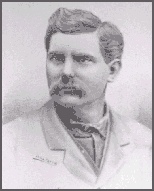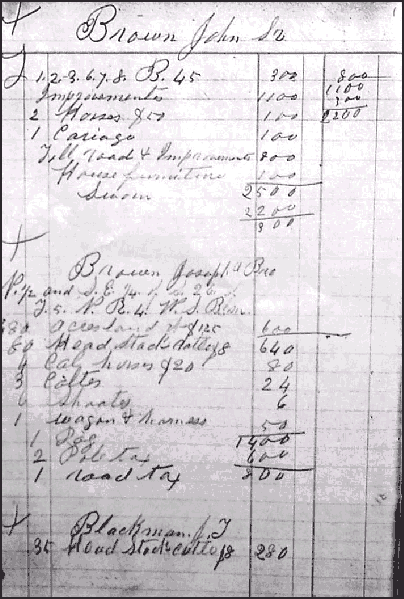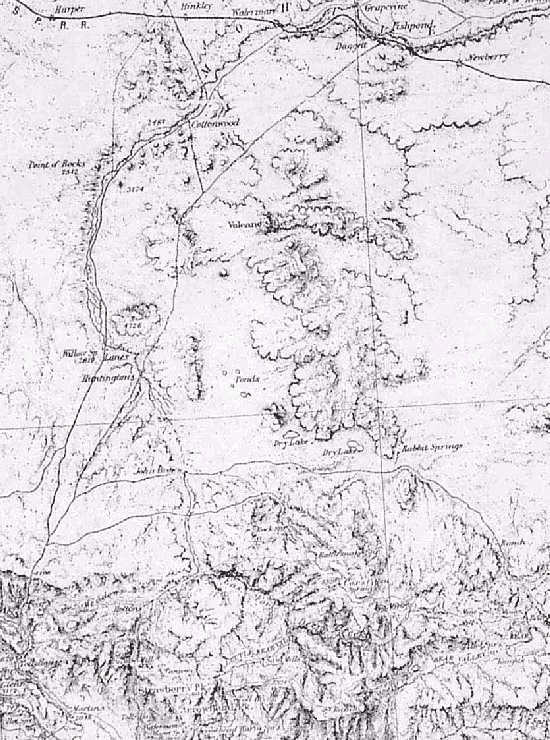

The initial piece of property was bought by John Brown Jr. and Joseph Thorn at $1.25 per acre (the current price for public land), for a total of $600 for three-quarters of Section 26, T. 5 N., R. 4 W. They bought it in 1869 but did not receive the patent until 1871, at which time Thorn, who was probably just a financial partner, ceded his interest to Brown in a land swap.
John Jr. likely bought the property for his brothers, since he was an adult and they were minors. John was born in 1847, so he would have been 21 years of age in 1869, 22 after his birthday (October 23). His brother Joseph was a year younger, James three years, and Newton eleven years.
The view that John just assisted his brothers is buttressed by the fact that Joseph filed a claim to 160 acres of adjacent land the following year on his own, as soon as he legally could. John sold the Section 26 property plus 480 acres of Section 36, making 960 acres in all, to Joseph and James in 1875.

The supposed founding date of 1867 for the ranch has a definite drawback: namely that there is testimony that nobody was living there then. George Miller said as much when he described chasing Indians that year with a group of trappers and scouts that was humorously dubbed the "Army of the Pacific."
In Annual Publications, Historical Society of Southern California, he told of tracking the Indians out to the desert and said, "We then moved down to the Mojave River to get closer to our work, in some heavy timber--the place is now known as the Verde Rancho; it was not owned by anybody at that time." He meant not "occupied" as can be seen by a close reading of the rest of the text.
Since they camped at the ranch site, in fact headquartered there, he would certainly have mentioned any improvements. And there was no one to feed him or his fellow Indian fighters. After a battle near present Lucerne Valley, the group had to return all the way to James Fears' Upper Toll House in Cajon Pass for food. "We hadn't had a square meal for thirty-two days," he complained.
The date the ranch was established can be determined with reasonable accuracy (within a year) thanks to the omniscient County Assessor. One might think that given the vast expanse of the County, the Assessor might miss a ranch now and then, but he seemed to know everything.
Prior to 1870 there were no entries for the Brown Ranch or any ranch that might conceivably have been located in Section 26 in the Assessment Records, but in 1870 there is an entry that states "Brown and Thorn, 480 acres of land" followed by the legal description. This entry was hatched out in pencil and was incomplete. There was no valuation, and only the land was listed, so it may just be a recognition that the land was purchased, and then scratched out because the transaction had not been consummated with the government as yet.
There is a clear entry for the following year showing the ranch as a working concern. One of the four assessment books for that year has a heading on the cover that reads, "assessment roll for fiscal year ending April 1871." That most likely signifies that an entry could have been made any time in the previous year, meaning that the Browns could have moved to the ranch sometime between May of 1870 and April of 1871. The Brown assessment appears on page 8 of an unnamed book. The heading reads, "Brown Joseph & Bro" and is reprinted here.

Joseph Brown turned 21 in 1870, and on September 5th of that year he began adding land to the original purchase. He filed a claim in Section 23 just north of the 480 acres his brother had purchased the year before. In that claim he said, "Notice is hereby given that I, Joseph Brown, have taken up, settled up on, occupy and claim for agricultural and grazing purposes" 160 acres of land, for which he gave the legal description. He also swore that he was a citizen of the United States over 21 years old.
Three months later John Sr. transferred the JB cattle brand to both Joseph and James, indicating that the two brothers were then in the cattle business. So we have Joseph's own statement that he had "settled upon" the land by September 1870, and this corresponds with the data provided in the Assessor's records.
This makes sense, considering the other developmental activity in the immediate vicinity that year. Earlier, Lafayette Mecham had cut a road directly through the desert from Fish Pond (Daggett) to Big Meadow (Victorville), and this route -- known today as Stoddard Wells Road -- became popular because it was shorter and firmer than the Mojave River Road, which had some sandy stretches. The Stoddard Wells route was extended to the south to make a connection with the Cajon Pass toll road. The combined roads became the major thoroughfare, and Lane's Crossing on the Mojave River Road became the secondary route, as this map shows

Quick to realize the economic importance of the new crossing, John J. Atkinson built a cabin in about 1870, downstream of the Upper Narrows. Partners A. F. (Frank) McKenney and Jesse W. Taylor followed with a supply station further downstream, approximately in the vicinity of where the present-day Southdown Cement Company's Mojave Northern Railroad crosses the river. Their possessory claim filing was the same month and year as Joseph Brown's, in September 1870.
It is understandable that the Browns came to their ranch after an access road was provided and adjacent lands were being settled. McKenney and Taylor's station (well known later in the 1870s as Huntington's) would be a welcome convenience as well as an economic factor in increasing land values.
An 1872 news account discusses James Brown's hunting exploits in the ranch area, an indication that he was either living or spending time there:
MOUNTAIN SHEEP -- We were presented on Friday, a fine ham of mountain sheep by Mr. James Brown, for which we say, "thank you," Jim. He succeeded in capturing this timid "varmint" at the great narrows on the Mojave River. A few days since he came very near throwing a lasso on one, in his endeavor to get from in front of a buck. |

 PAGE
1|
2|
3|
4
PAGE
1|
2|
3|
4

